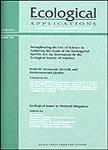版权所有:内蒙古大学图书馆 技术提供:维普资讯• 智图
内蒙古自治区呼和浩特市赛罕区大学西街235号 邮编: 010021

作者机构:Stockholm Univ Stockholm Resilience Ctr Kraftriket Sweden Univ Oslo Ctr Ecol & Evolutionary Synth Oslo Norway Univ South Pacific Sch Marine Studies Suva Fiji James Cook Univ ARC Ctr Excellence Coral Reef Studies Townsville Qld Australia Silliman Univ Angelo King Ctr Res & Environm Mana Dumaguete Philippines Tokyo Inst Technol Nadaoka Lab Dept Civil Engn Tokyo Japan Univ Queensland Brisbane Qld Australia Univ Leeds Sch Biol Fac Biol Sci Leeds W Yorkshire England Univ Melbourne Melbourne Vic Australia Deakin Univ Sch Life & Environm Sci Geelong Vic Australia
出 版 物:《ECOLOGICAL APPLICATIONS》 (Ecol. Appl.)
年 卷 期:2019年第29卷第1期
页 面:1-10页
核心收录:
学科分类:0710[理学-生物学] 0830[工学-环境科学与工程(可授工学、理学、农学学位)] 07[理学] 09[农学] 0713[理学-生态学]
基 金:ARC Centre of Excellence for Coral Reef Studies Australian Research Council ARC FORMAS 2015-2016 BiodivERsA COFUND
主 题:conservation planning larval networks marine protected areas metapopulation PageRank algorithm Philippines scheduled implementation
摘 要:Instantaneous implementation of systematic conservation plans at regional scales is rare. More typically, planned actions are applied incrementally over periods of years or decades. During protracted implementation, the character of the connected ecological system will change as a function of external anthropogenic pressures, local metapopulation processes, and environmental fluctuations. For heavily exploited systems, habitat quality will deteriorate as the plan is implemented, potentially influencing the schedule of protected area implementation necessary to achieve conservation objectives. Understanding the best strategy to adopt for applying management within a connected environment is desirable, especially given limited conservation resources. Here, we model the sequential application of no-take marine protected areas (MPAs) in the central Philippines within a metapopulation framework, using a range of network-based decision rules. The model was based on selecting 33 sites for protection from 101 possible sites over a 35-yr period. The graph-theoretic network criteria to select sites for protection included PageRank, maximum degree, closeness centrality, betweenness centrality, minimum degree, random, and historical events. We also included a dynamic strategy called colonization-extinction rate that was updated every year based on the changing capacity of each site to produce and absorb larvae. Each rule was evaluated in the context of achieving the maximum metapopulation mean lifetime at the conclusion of the implementation phase. MPAs were designated through the alteration of the extinction risk parameter. The highest ranked criteria were PageRank while the actual implementation from historical records ranked lowest. Our results indicate that protecting the sites ranked highest with regard to larval supply is likely to yield the highest benefit for fish abundance and fish metapopulation persistence. Model results highlighted the benefits of including network